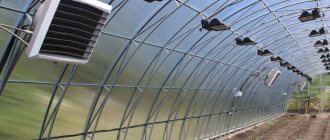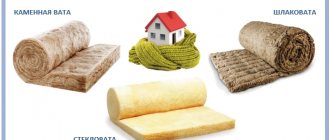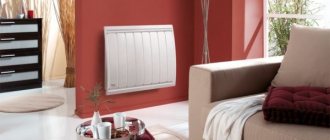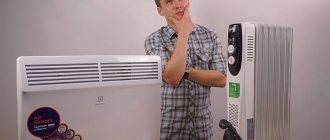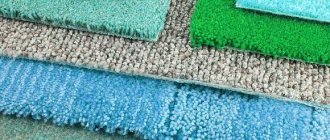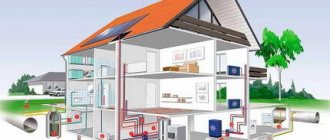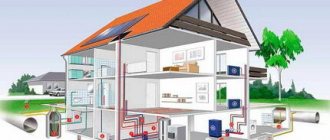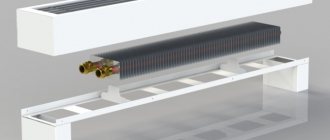In the off-season, when it is already cold and damp, sales of electric heaters increase sharply. The most popular types of appliances are convectors and fan heaters. They are inexpensive, compact, perfectly heat rooms and are in approximately the same demand.
And yet there is a significant difference between them. In this article, we will figure out which is better – a convector or a fan heater for heating a house, taking a close look at each type of heater. We will also dwell on the operating principle and design of each of them, and provide a list of the best equipment manufacturers according to customers.
Features of using heating devices
Fan heaters and convectors are often purchased for apartments in high-rise buildings, but sometimes they are also needed in houses. In an apartment, the heater serves as the main heating system in cold weather, and in a private house the owner can use it as an additional and/or alternative heating system.
The devices are also installed in rooms that require special temperature conditions (children's rooms, bathrooms, etc.).
Fan heaters are ideal if you need to quickly warm up the air. They are indispensable in the cold season at dachas, garages, workshops, etc. Convectors require more time, but their operation is more stable and energy consumption for heating is less
The basis for a meaningful choice of any device is an understanding of the principle of its operation, design, disadvantages and advantages. There is no ideal and universal technology, so you need to figure out which models are best suited for specific operating conditions. You should also decide on your own needs, priorities and expectations.
Reviews about what is better to buy - a convector or a fan heater
Krivtsov Andrey Viktorovich, 33 years old, Yaroslavl
A year ago I bought an electric convector for my apartment, so far I’m happy with everything. It has become much easier to survive periods without heating in the fall and spring, the family does not freeze, and the child does not catch a cold. Electricity consumption is generally moderate, without large overpayments.
Makeeva Anna Nikolaevna, 38 years old, Kaluga
I use a heat fan at the dacha, the device is convenient and compact. Unlike a radiator, it makes a loud noise, but you don’t have to wait several hours for the temperature in a cold house to rise sufficiently. If necessary, you can quickly dry wet clothes or shoes under the air flow.
Main characteristics of the fan heater
Fan heaters are inexpensive and efficient devices that are purchased for heating residential, administrative, and industrial premises.
By choosing the right model, you can create a warm zone within a few minutes. To do this, you just need to point the fan heater in the desired direction and turn it on.
This is an excellent choice if you need to quickly warm the air in a separate area of the room. Such fan heaters are installed next to beds and work tables. They are also used if you urgently need to finish drying washed items.
Large stationary models are installed on the floor or mounted on walls, while mobile ones are easy to carry, rotate, and move to another location.
The housings of the devices do not overheat, so there are no special requirements for surfaces. Fan heaters are placed on any floor coverings, tables, cabinets.
An ideal option for heating a living space or office during the off-season. The model can be installed so that it creates a thermal curtain at the entrance to the room or at the window
Operating principle of the device
The principle of operation is simple: cold air enters a closed or open heating element, instantly warms up, and the fan throws it out.
The result is the effect of a warm wind that blows across people and objects in the room. Heated air flows are mixed with cold ones, thanks to which a comfortable temperature is quickly established in the room.
Hot air moves forward - in the direction where the device is pointed, and then rises. The distance that the heat flow travels depends on the power and design features of the model
When choosing, focus on the desired power and noise level. We recommend looking at detailed recommendations for choosing a fan heater, taking into account key criteria.
The choice is also influenced by the type of heating element of the fan heater, depending on which the following types of devices are distinguished:
- Spiral . The heaters are made of spiral nichrome wire. In working condition, their temperature can reach 800°C. Despite their high efficiency, these heaters are considered not the best choice, because... During operation they burn dust and moisture.
- Heating elements. The temperature of the heating element does not exceed 200°C, but this does not affect the quality of work due to its large area. The models are fireproof, convenient, but more expensive than spiral models.
- Ceramic . The elements heat up much less - up to 200°C, and do not burn out the air. They are absolutely safe and easy to use.
Spiral models have almost lost their popularity among buyers. Because as a result of their work, the air becomes dry and an unpleasant odor appears.
Users call the ceramic fan heater the most preferred option. This is the best choice for today. If you buy a model from a reliable brand, it will serve for a long time and without failure.
Advantages and disadvantages of fan heaters
The advantages of fan heaters include compactness and high air heating speed. Almost all models are equipped with control panels for operating modes, temperature sensors, and some also have remote controls.
In some cases, uneven heating is a plus. If some area in the room needs more intense heating than others, you should choose a fan heater
Fan heaters also have disadvantages: noise during operation and uneven heating of the room.
As for noise, it is impossible to completely solve this problem. The rotating fan blades will make sounds in any case. The noise may be greater or less, but it will always be there. You'll have to come to terms with this.
Brief overview of the best brands
In the rankings of the best manufacturers of fan heaters, the leaders are the same companies that produce the most reliable convectors: Ballu, Timberk, Vitek, Electrolux, Saturn, Polaris, AEG, NeoClima, Scarlett, Teplomash and others.
Image gallery
Photo from
Ballu - inexpensive spiral models
Electrolux - the best wall-mounted models
Vitek – reliable floor fan heaters
"Teplomash" - the best heating element fan heaters
When choosing a fan heater or convector, it is worth considering that many of them are assembled in China. It is better to pay attention to manufacturers who strictly control product quality and buy models from those brands that have well-organized service centers.
Have you decided to get a fan heater, but don’t want to overpay for the brand? In this case, you can assemble a homemade fan heater from scrap materials.
Convectors - operating principle, pros and cons
When heating a room with this electric heater, cold air passes through the grille, which is located at the bottom of the convector, and then through the heating element. As a result, warm air comes out through the grille on the top panel and is distributed throughout the room. Most models boast moisture resistance, so they can be used in saunas and bathrooms. Convectors come in different types:
- Gas - expensive due to the need to connect to the gas main;
- Electric - the simplest and most common;
- Water;
- Infrared.
When comparing a convector and a fan heater, it becomes clear that the first one is much more complex in design. By type of location, convectors are:
- Floor-standing;
- Wall-mounted;
- Combined;
- In-floor.
See also -
Which electric convector is better to buy for your home?
Convector advantages:
- The air heats up quickly;
- Fire safety;
- Various mounting options;
- You can select the desired temperature level;
- You can create a network of several devices;
- Quiet operation;
- Safe to use;
- Compactness;
- Durability.
Flaws:
- It can take a long time to heat up to the optimal temperature;
- Afraid of drafts - it breaks down;
- A power failure will cause a breakdown;
What type of heating device is better to choose?
It all depends on the goals of the owner of the premises. If you need to achieve uniform heating of the entire area, and speed is not important, then it is better to install a convector.
If the main goal is to obtain a directed flow of hot air and instant heating of a specific area in the room, a fan heater would be the best choice.
You can easily install a fan heater in your home office or office. The measured hum of the blades will not interfere, but will only help you concentrate, cutting off external sound stimuli
In residential premises, convectors are often installed due to the lack of noise, and for an office, where there is always some sound, a fan heater is appropriate.
None of the devices discussed above suits you? We recommend that you familiarize yourself with the most popular types of heaters for homes and apartments, and tips for choosing the best one.
Making the right choice
When asking which is better: a convector or a fan heater, you should focus on the following selection criteria:
- If you plan that the equipment will work for years, then it is better to choose a convector. It can also heat several rooms well at once (if connected to a network). The decisive advantage will be the presence of a thermostat in the model, which will allow you to set the temperature.
- When the goal is to quickly warm up a room over a short period of time, it is worth choosing a fan heater.
- It would be even more interesting to duplicate the operation of both autonomous heating systems: first, the fan heater will warm the air in the room, then the convector will get to work, which will maintain the required temperature.
We calculate energy costs
You can save money by installing one wide appliance under a large window instead of several compact ones.
Electric heating convectors for cottages, wall-mounted and economical, work as independent or auxiliary heating devices, differing in their power. Considering the compactness of most dachas, they have small dimensions. They are also characterized by an affordable price, since in most cases, the dacha does not need any design delights. However, for country houses with designer interiors, you can purchase any suitable convector type heaters.
Why is it beneficial to use convectors in a dacha? The following factors are taken into account:
- compactness - the same oil radiators are much larger in size but less efficient;
- silent operation – fan heaters heat just as efficiently, but they make a lot of noise;
- low cost - electric convectors for summer cottages are the simplest models, so they are characterized by an affordable price.
Based on this, electric heaters for summer cottages are the optimal solution for organizing autonomous heating.
As we have already said, country electric convectors can work as main or auxiliary equipment. Working as the main equipment, they ensure complete heating of the premises in accordance with the set temperature. If the house already has a heating system, then convector heaters can operate in auxiliary mode, for example, during severe winter cold.
A small electric heater will be a great help if you have small children: by installing it in the room where the child sleeps, you will create comfortable sleeping conditions. Convectors are also useful as auxiliary equipment in very freezing rooms where the main heating cannot cope.
Since the equipment runs on electricity, its costs will be high. They depend on the air temperature outside, on severe frosts, on the presence of effective insulation of the country house, as well as on the area of the heated premises. Electronic control contributes some of the savings - it provides more accurate temperature monitoring.
As you can see, the price for heating with electricity is the highest, but you do not need to install heating boilers and lay pipes.
Let's calculate the approximate costs of heating a small country house with an area of 20 square meters. m. To heat it, we will need a radiator with a capacity of 2 kW (taking into account that the house has good thermal insulation and triple glazed windows are installed in it). If the heating operates around the clock without turning off, the electricity consumption will be 1440 kW per month. This figure must be multiplied by the cost of one kilowatt in your region.
For example, if the cost of one kilowatt is about 4 rubles, then the cost of heating the house will be 5,760 rubles. Special rates often apply to dacha communities and rural areas. If this rural tariff is 3 rubles per kilowatt, monthly expenses will be 4,320 rubles. Since convectors are equipped with regulators, they will not work around the clock. If we assume that they work 12 hours a day (obeying the commands of the thermostat), then the monthly consumption will be 720 kW, or 2160 rubles at the rural tariff.
Do you only go to your dacha on weekends? Then heating costs will be even lower. They will grow only if frost protection is used, which maintains the temperature in the country house at +5 degrees.
About the negative aspects
Having studied the first part of the article, the reader may decide that micathermic household heaters are just another piece of junk and there is no need to buy them. Don’t rush to conclusions and first familiarize yourself with the shortcomings of the devices, of which there are only three:
- A negative property of all infrared heaters: the heating intensity decreases with distance from the radiation source. Since heat waves propagate strictly in the zone of action of the radiating elements, warming up a cold room takes 2-5 hours.
- Through the perforation of the grille, dust penetrates into the device and settles on the mica coating. After switching on, the dusty layer begins to burn out within 10-15 minutes, spreading a characteristic odor.
- Products made using Mica-thermic technology are not cheap. Below is a comparative table with the prices of various heaters of the same power of 1500 W from the famous Polaris brand.
| Heater type | Mica-thermic | Ceramic | Oil | Convector | Fan heater |
| Price, y. e. | 80 | 21 | 52 | 55 | 16 |
| Cost, rub. | 4600 | 1230 | 3000 | 3200 | 940 |
A heating element
Tabletop fan heaters, in turn, are divided into two types:
with spiral heating element
with ceramic
Which one is better to choose and what are their differences from a practical point of view? A spiral is always several hundred rubles cheaper than ceramics.
The spiral element is actually a nichrome wire that heats up very quickly to its operating temperature when voltage is applied to it. Heat is removed from the wire by blowing.
The temperature of such wire reaches 800 degrees! A ceramic, or rather metal-ceramic element (there is negligible ceramics there), consists of two components - aluminum and ceramics.
If you take two heaters of the same size and compare the usable area of their heating elements, then ceramics wins significantly in this matter. However, it heats up to much lower temperatures (100-150C).
The most important difference between these elements is the difference in the feeling of comfort. And she really is present.
Nothing like that actually happens. It’s just that they all change the humidity in the room very much. In other words, they dry the air.
Where does the difference in sensations in an apartment come from when heated with ceramics and a spiral?
The fact is that when air flows pass through the fan heater, dust also passes through it. Dust particles settle on the hot spiral and burn out instantly.
There is a corresponding smell in the room and a feeling of lack of oxygen. The air dries at an accelerated pace.
Many people do not recommend installing spiral blowers in rooms with flowers. They grow very poorly and may simply die over the winter.
Any containers with water in front of the heaters not only do not help, but are also dangerous. This should not be placed in front of open elements of electrical appliances.
There are models with filters, but sometimes they only make things worse. Here's a typical review.
Ceramic elements do not burn dust or dry air in such volumes as a spiral, so your well-being does not deteriorate when using them.
What conclusion can be drawn from this? Very simple - for home use, buy only models with a metal-ceramic heating element. Your well-being and the health of your children are not worth the saved two or three hundred rubles.
Infrared wall heaters
Infrared devices are a panel with a heat exchanger inside. Such heaters heat with infrared radiation, which means the area of such devices must be larger than, for example, a quartz heater, which is unlikely to be able to warm anything.
Infrared lights also produce long-wave radiation that is pleasant to humans. But the convection of such devices will be comparable to a conventional convector, because they do not have sections, but they do not need this, since their main heating method is infrared radiation, which they cope with very well.
Pros:
- Pleasant warmth
- Acceptable price
- Easy installation
Minuses:
- Not suitable for main heating
- Poor convection
- Noticeable electricity consumption
Useful tips
Models with a ceramic heating element are more expensive. But they perform much better in operation.
In the store, look at the back panel of the device. If you see a sponge filter for coarse cleaning, then know that the air in the room will be much cleaner.
The optimal power of the device is from 1 to 3 kW. In order for the device to be easy and convenient to use, the power must be adjusted smoothly.
Read more: Pipe cutter for metal-plastic pipes: advantages and disadvantages of different types; example of work
It makes sense to buy devices that have a well-thought-out security system. It should provide protection against overheating and will automatically turn off the device if it is suddenly knocked over.
A fan heater should be used to dry cottages after winter or in small rooms with drafts. The device is convenient when there is a need to warm up the room frequently and quickly.
Enterprises produce models of various types - gas, electric, water. However, practice has shown that electric convectors are more often on sale. These are the ones that Russian buyers prefer.
Gas or water models are also in demand. They are bought by those who have a house or dacha outside the city. These devices are less suitable for an apartment.
When choosing a device, pay attention to products under the brand of well-known manufacturers. It makes sense to choose a model with an electronic thermostat. After all, it will control temperature changes. Moreover, with an accuracy of 1 degree.
Electric convectors are very good for a small room with low or standard ceilings. When the ceiling height exceeds three meters, a fan heater is better. Better yet, several fan heaters. Then they will quickly warm the air and mix it. And as a result, strong cooling will not occur.
Convectors with a power from 0.25 to 2.5 kWe are good for home use. The power depends on the area of the room. There is a reason to find out in the store the heating temperature of the case. Let's say, to work in a children's room, the case needs to heat up to 55 degrees.
